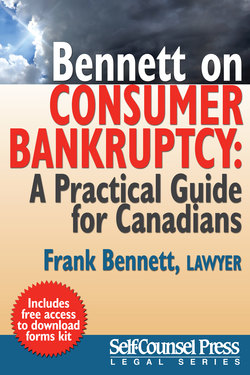Читать книгу Bennett on Consumer Bankruptcy - Frank Bennett - Страница 10
На сайте Литреса книга снята с продажи.
4. Exempt Property
ОглавлениеWhen the consumer debtor goes bankrupt, all of the property that is owned by the debtor and property that the debtor inherits or acquires after bankruptcy up to the time the debtor gets out of bankruptcy automatically belongs to the trustee in bankruptcy without any need or requirement to transfer or register ownership, except for real estate. The trustee in bankruptcy must sell the debtor’s eligible or non-exempt property and then distribute the sale proceeds amongst the creditors. Eligible property includes all kinds of property wherever it is whether inside or outside Canada. Property that is acquired by the bankrupt after bankruptcy up to the time of discharge is called “after-acquired” property. It usually includes wages, commissions, inheritances from family members, and winnings from lottery tickets.
However, not all property goes to the trustee. In each province and territory, there are exemptions for bankrupts. These exemptions provide that the consumer debtor, now the bankrupt, can keep certain kinds of property. In other words, creditors cannot seize this type of property. While this is covered a little later in the book, in Chapter 6, the consumer debtor should note that he or she can keep most of the wages, vehicles, tools of the job, generally all clothing, furniture, pension funds, RRSP money with the exception of money deposited within the last year before bankruptcy, insurance proceeds, and proceeds arising out of a personal injury action.
